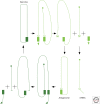Hepatitis D Virus Replication
- PMID: 26525452
- PMCID: PMC4632862
- DOI: 10.1101/cshperspect.a021568
Hepatitis D Virus Replication
Abstract
This work reviews specific related aspects of hepatitis delta virus (HDV) reproduction, including virion structure, the RNA genome, the mode of genome replication, the delta antigens, and the assembly of HDV using the envelope proteins of its helper virus, hepatitis B virus (HBV). These topics are considered with perspectives ranging from a history of discovery through to still-unsolved problems. HDV evolution, virus entry, and associated pathogenic potential and treatment of infections are considered in other articles in this collection.
Copyright © 2015 Cold Spring Harbor Laboratory Press; all rights reserved.
Figures



References
-
- Alves C, Freitas N, Cunha C. 2008. Characterization of the nuclear localization signal of the hepatitis delta virus antigen. Virology 370: 12–21. - PubMed
-
- Bergmann KF, Cote PJ, Gerin JL. 1990. Immunological characterization of hepatitis delta antigen. In Progress in clinical and biological research (ed. Gerin JL, Purcell RH, Rizetto M), pp. 165–171. Wiley, New York. - PubMed
Publication types
MeSH terms
LinkOut - more resources
Full Text Sources
Other Literature Sources
